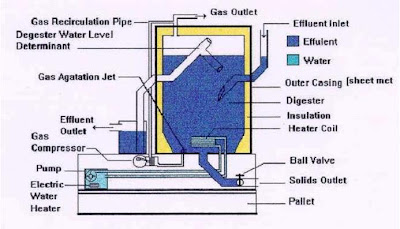The Design and Theory of a Basic Anaerobic Digester
With environmental issues such as the greenhouse effect and correct waste disposal methods gaining much attention throughout the community, the concept of controlled anaerobic digestion is perhaps a much overlooked example of a way to reduce green house gas emissions and provide a better waste disposal method for organic waste.
Introduction
Controlled anaerobic digestion is by no means a radical or new concept. Large scale industrial digesters and small domestic digesters are in operation in many places around the world. The purpose of all these digesters is to produce combustible biogas which can be burned to provide energy for a whole range of uses. Here in Australia, there is quite a bit of ideological interest in anaerobic digestion and biogas production, particularly from intensive farmers, but there are not many examples of digesters in operation. These farmers are interested in this topic primarily as an alternative energy source (biogas), and secondly, as part of an efficient effluent waste disposal system for the farm. Somehow there seems to be a problem in finding ways to put controlled anaerobic digestion into practice on the average Australian farm. There is almost a small library of information from all over the world on this topic, but this information doesn't seem to be reaching the average intensive farmer with some interest in this topic. Why isn't this concept being utilized more? There could be a number of possible reasons for this including the capital cost of setting up an anaerobic digester project, a lack of working models and / or a lack of a source of ideas to base individual projects on, i.e. - trouble shooting and project development at a technical 'on farm' level. The purpose of this project was to develop a small scale working prototype possibly suited to operate on the average farm. The focus of this project was the production of usable (combustible) biogas. This project is definitely not supposed to be revolutionary or radically new, but rather to be a starting point for further research and development in this area. The purpose of this report is not to provide a method for the fabrication of the project produced (although a basic materials list will be provided). Rather, this report will aim to identify key aspects of the design, concentrating on their function and the theory behind their function. Therefore, the aim of this report is to provide the reader with a
basic explanation of the mechanics of a small, continuous flow anaerobic digester.
Download PDF The Design and Theory of a Basic Anaerobic Digester
With environmental issues such as the greenhouse effect and correct waste disposal methods gaining much attention throughout the community, the concept of controlled anaerobic digestion is perhaps a much overlooked example of a way to reduce green house gas emissions and provide a better waste disposal method for organic waste.
Introduction
Controlled anaerobic digestion is by no means a radical or new concept. Large scale industrial digesters and small domestic digesters are in operation in many places around the world. The purpose of all these digesters is to produce combustible biogas which can be burned to provide energy for a whole range of uses. Here in Australia, there is quite a bit of ideological interest in anaerobic digestion and biogas production, particularly from intensive farmers, but there are not many examples of digesters in operation. These farmers are interested in this topic primarily as an alternative energy source (biogas), and secondly, as part of an efficient effluent waste disposal system for the farm. Somehow there seems to be a problem in finding ways to put controlled anaerobic digestion into practice on the average Australian farm. There is almost a small library of information from all over the world on this topic, but this information doesn't seem to be reaching the average intensive farmer with some interest in this topic. Why isn't this concept being utilized more? There could be a number of possible reasons for this including the capital cost of setting up an anaerobic digester project, a lack of working models and / or a lack of a source of ideas to base individual projects on, i.e. - trouble shooting and project development at a technical 'on farm' level. The purpose of this project was to develop a small scale working prototype possibly suited to operate on the average farm. The focus of this project was the production of usable (combustible) biogas. This project is definitely not supposed to be revolutionary or radically new, but rather to be a starting point for further research and development in this area. The purpose of this report is not to provide a method for the fabrication of the project produced (although a basic materials list will be provided). Rather, this report will aim to identify key aspects of the design, concentrating on their function and the theory behind their function. Therefore, the aim of this report is to provide the reader with a
basic explanation of the mechanics of a small, continuous flow anaerobic digester.
Download PDF The Design and Theory of a Basic Anaerobic Digester



0 comments:
Post a Comment